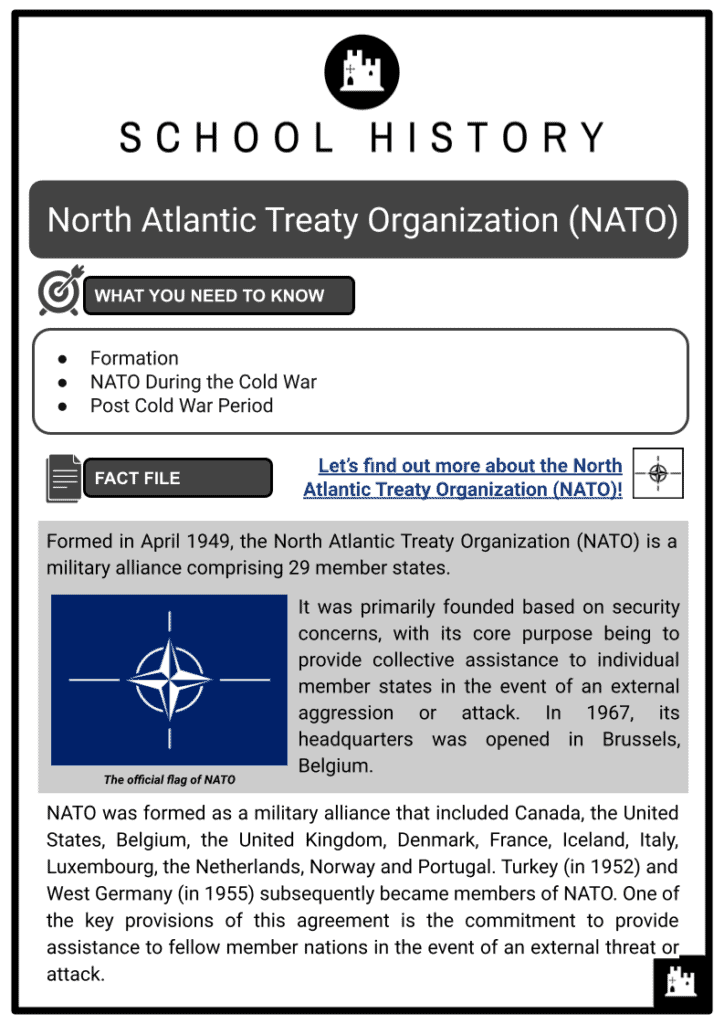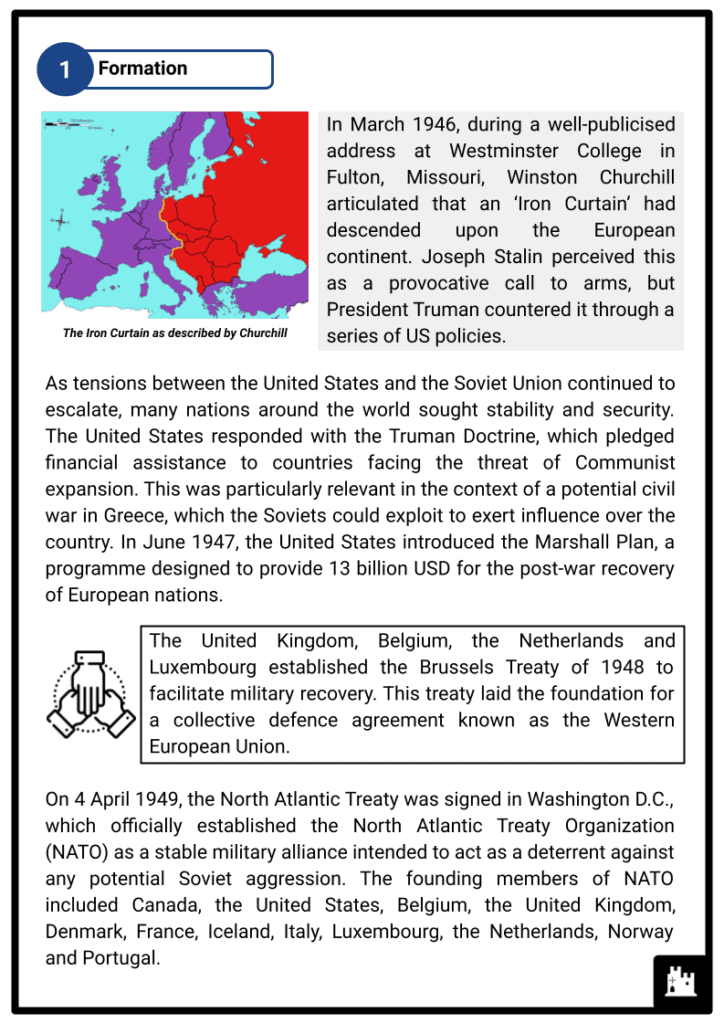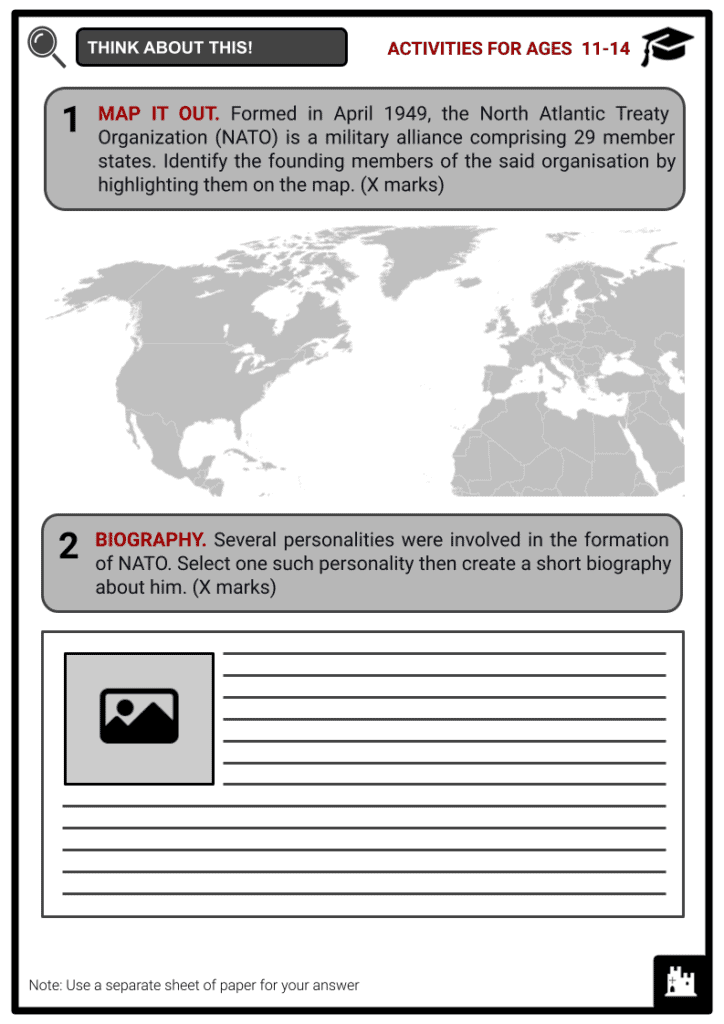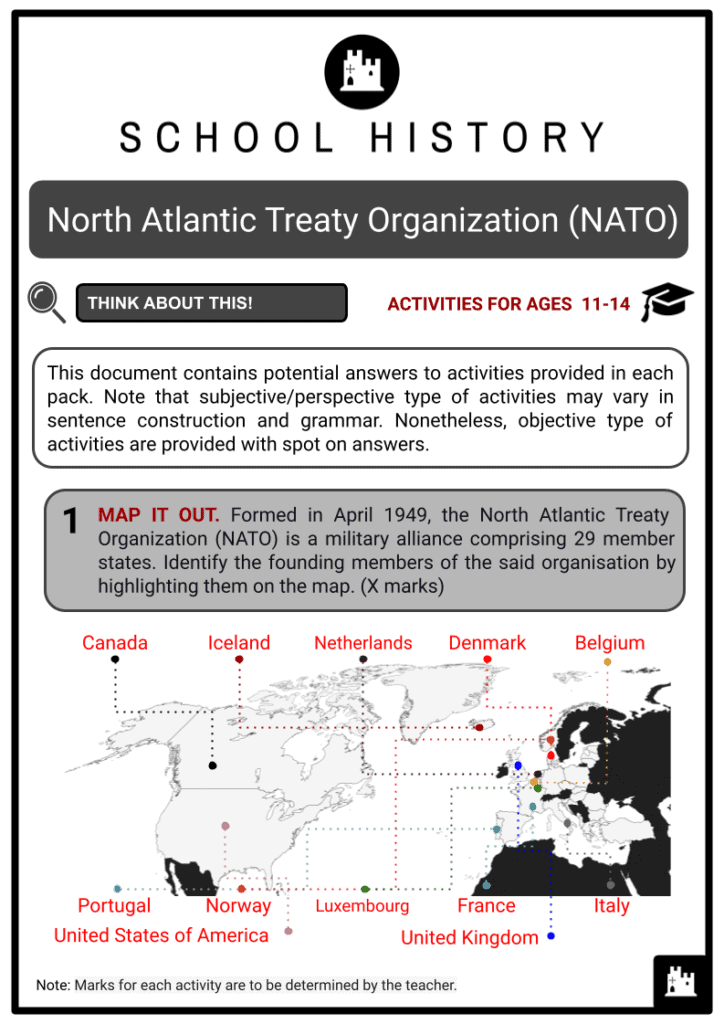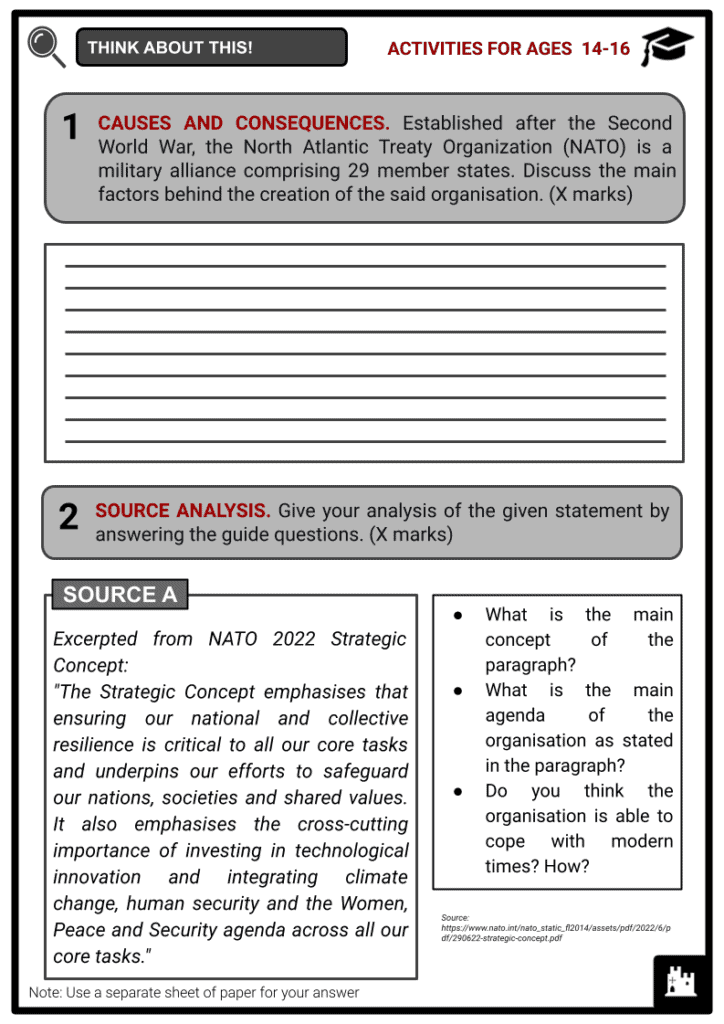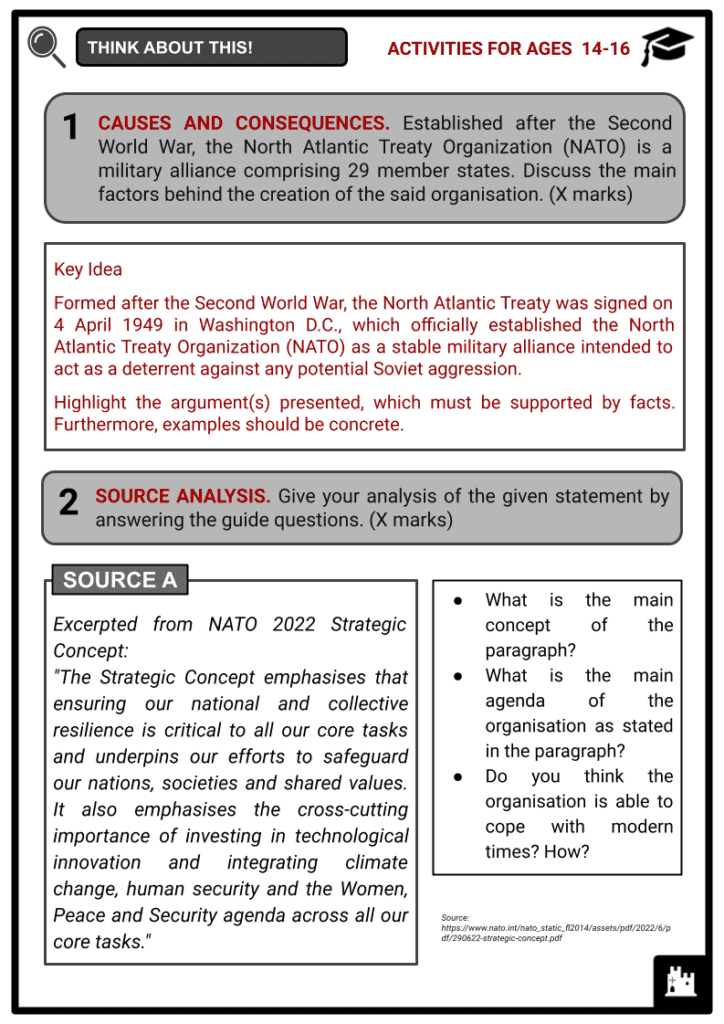NATO Worksheets
Do you want to save dozens of hours in time? Get your evenings and weekends back? Be able to teach about NATO to your students?
Our worksheet bundle includes a fact file and printable worksheets and student activities. Perfect for both the classroom and homeschooling!
Summary
- Formation
- NATO During the Cold War
- Post Cold War Period
Key Facts And Information
Let’s find out more about the North Atlantic Treaty Organization (NATO)!
Formed in April 1949, the North Atlantic Treaty Organization (NATO) is a military alliance comprising 31 member states (as of 2023). It was primarily founded based on security concerns, with its core purpose being to provide collective assistance to individual member states in the event of an external aggression or attack. In 1967, its headquarters was opened in Brussels, Belgium.
NATO was formed as a military alliance that included Canada, the United States, Belgium, the United Kingdom, Denmark, France, Iceland, Italy, Luxembourg, the Netherlands, Norway and Portugal. Turkey (in 1952) and West Germany (in 1955) subsequently became members of NATO. One of the key provisions of this agreement is the commitment to provide assistance to fellow member nations in the event of an external threat or attack.
Formation
- In March 1946, during a well-publicised address at Westminster College in Fulton, Missouri, Winston Churchill articulated that an ‘Iron Curtain’ had descended upon the European continent. Joseph Stalin perceived this as a provocative call to arms, but President Harry Truman countered it through a series of US policies.
- As tensions between the United States and the Soviet Union continued to escalate, many nations around the world sought stability and security. The United States responded with the Truman Doctrine, which pledged financial assistance to countries facing the threat of Communist expansion. This was particularly relevant in the context of a potential civil war in Greece, which the Soviets could exploit to exert influence over the country. In June 1947, the United States introduced the Marshall Plan, a programme designed to provide 13 billion USD for the post-war recovery of European nations.
- The United Kingdom, Belgium, the Netherlands and Luxembourg established the Brussels Treaty of 1948 to facilitate military recovery. This treaty laid the foundation for a collective defence agreement known as the Western European Union.
- On 4 April 1949, the North Atlantic Treaty was signed in Washington D.C., which officially established the North Atlantic Treaty Organization (NATO) as a stable military alliance intended to act as a deterrent against any potential Soviet aggression. The founding members of NATO included Canada, the United States, Belgium, the United Kingdom, Denmark, France, Iceland, Italy, Luxembourg, the Netherlands, Norway and Portugal.
- Subsequently, several countries joined NATO over the years, including Greece (1952), Turkey (1952), West Germany (1955), Spain (1982), Czech Republic (1982), Hungary (1982), Poland (1982), Bulgaria (2004), Estonia (2004), Latvia (2004), Lithuania (2004), Romania (2004), Slovakia (2004), Slovenia (2004), Albania (2009), Croatia (2009), Montenegro (2017), North Macedonia (2020), and Finland (2023).
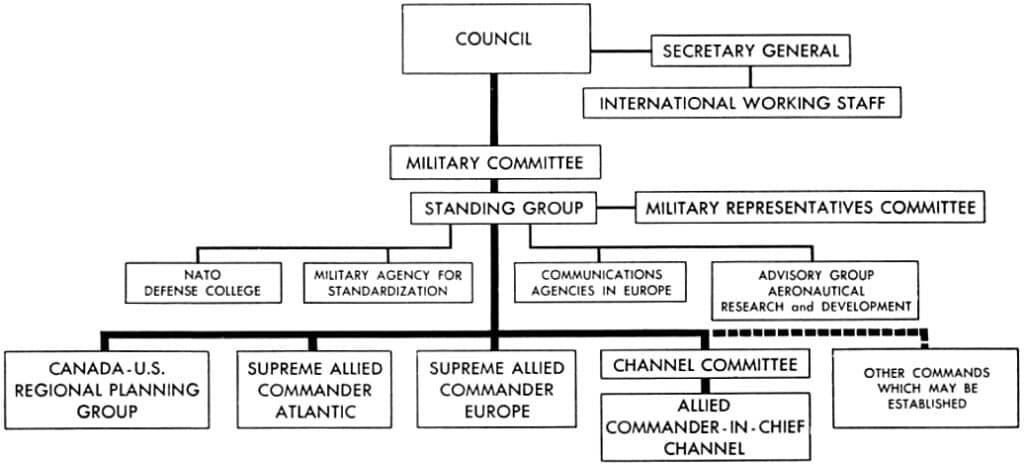
The organisational structure of NATO, 1952 - The governing body of NATO, the North Atlantic Council, was established. It consists of representatives from each member state who convene at least twice annually and is presided over by the NATO secretary-general, traditionally held by a European leader. In December 1950, General Dwight D Eisenhower was appointed as the council’s first Supreme Allied Commander Europe (SACEUR), and subsequent to him, American generals occupied this position.
- NATO’s military structure includes a Military Committee comprised of military chiefs from member states and features two strategic commands: Allied Command Operations (ACO), led by the SACEUR based in Casteau, Belgium, under the Supreme Headquarters Allied Powers Europe (SHAPE), and Allied Command Transformation (ACT), located in Norfolk, Virginia, USA.
NATO During the Cold War
- In response to the creation of NATO, the Soviet Union initiated the establishment of the Warsaw Pact on 14 May 1955 in Warsaw, Poland, as a collective defence treaty. Its founding members predominantly consisted of Eastern European nations, including Albania, Bulgaria, Czechoslovakia, East Germany, Hungary, Poland, Romania and the USSR. This development transpired after West Germany acceded to NATO.
- In 1966, the President of the Republic of France, Charles de Gaulle, declared their intent to withdraw from NATO’s military structure, citing its dominance by US military authorities. Nevertheless, France continued to pledge its support to the alliance in case of an external attack on member states, ultimately rejoining the military structure in 2009. By 1967, NATO’s headquarters had been relocated from Paris, France, to Brussels, Belgium.
- Throughout the Cold War era, NATO’s primary objective was to unite member states in response to the potential invasion by the Soviet Union in Western Europe and the looming threat of nuclear conflict in the event of such an incursion. Subsequently, in a bid to avert a large-scale nuclear war, the alliance adopted the Flexible Deterrent Options Strategy. Under this strategy, a member state could launch a retaliatory strike under a dual-key system involving the potential use of nuclear weapons, subject to approval by the United States and the respective member states. Alternatives to nuclear response included diplomatic measures and the deployment of conventional weapons and armaments.
- Numerous events posed additional challenges to the military alliance, such as the construction of the Berlin Wall in 1961, the period of détente starting in 1969, and the Soviet Union’s invasion of Afghanistan in 1979. In 1989, Soviet leader Mikhail Gorbachev altered the course of Cold War dynamics by announcing that the Soviet Union would no longer engage in invasions to establish Communist states as part of his policies, known as perestroika (restructuring) and glasnost (openness).
- In 1991, the dissolution of the Warsaw Pact raised questions about the continued relevance of NATO, given that its original raison d’être had dissipated. Consequently, to ensure its stability, the North Atlantic Cooperation Council was established to facilitate discussions between NATO member states, former Soviet states and Eastern European nations. By 1993, the alliance extended partnership offers to former Warsaw Pact members through the Partnership for Peace (PfP) programme.
- In conclusion, NATO’s function during the Cold War was essentially focused on collective defence, with an emphasis on preventing Soviet Union aggression and guaranteeing the security and stability of Western Europe. As described in Article 5 of the NATO treaty, an attack on one member country would be seen as an attack on all members, which called for a coordinated response. This was to act as a deterrent to discourage the Soviet Union and its allies from attacking Western Europe.
Post-Cold War Period
The military alliance ensured the continuity of its core mission even after the Cold War, which was to safeguard peace and security among its member nations.
1995
- NATO made a historic decision by deploying its military force in Bosnia and Herzegovina. This intervention involved using airstrikes against Bosnian Serb forces in Sarajevo to compel them to engage in peace negotiations.
1999
- NATO initiated an 11-week campaign of airstrikes against Yugoslavia in response to the grave ethnic cleansing of Albanians taking place in Kosovo.
2001
- Following the September 11 attacks in the United States, NATO debated applying Article 5 of its treaty, which states that an assault on one member state constitutes an attack on all. However, the US government ultimately chose not to invoke NATO’s assistance in subsequent military operations against the Taliban in Afghanistan, leading to a separate US-led effort.
2003
- NATO also supported military operations conducted by its member states, such as its involvement in the Iraq War in 2003, where it provided assistance to the United States.
2008
- Operation Ocean Shield was launched to combat piracy off the coast of Somalia. Here, NATO ships and equipment patrolled the Indian Ocean and Gulf of Aden to thwart piracy. The reduction of pirate attacks, the improvement of marine security and the facilitation of relief delivery to Somalia were all achieved by this operation.
2011
- NATO adopted Operation Unified Protector throughout the Libyan Civil War. NATO forces put in place an arms embargo, maintained a no-fly zone and carried out airstrikes on Muammar Gaddafi’s supporters. The operation was crucial in aiding anti-Gaddafi rebels and ultimately resulted in the overthrow of the Gaddafi government.
Syrian Civil War
- As part of the ongoing Syrian Civil War, NATO has been conducting Operation Active Fence to secure the southern Turkish border with Syria. NATO’s member state, Turkey, has been active in the Syrian war. Turkey has asked NATO for assistance to deal with the Syrian Civil War, particularly regarding border security and the refugee problem. The organisation has provided Turkey with defensive measures, such as deploying Patriot missile batteries.
Ukraine
- Following Russia’s annexation of Crimea in 2014 and its engagement in the Eastern Ukraine conflict, relations between NATO and Russia have been strained. NATO’s response was to strengthen its Eastern Flank security posture, hold military drills and support Ukraine. In the face of potential Russian threats, the alliance remains on guard. It had stationed 40,000 troops along its 2,500-kilometre (1,550 mi) Eastern flank as of June 2022. Over 50 per cent of them have been deployed to Poland, Bulgaria, Romania, Hungary and other neighbouring nations.
Air Policing in the Baltic
- To safeguard the airspace of the Baltic states (Estonia, Latvia and Lithuania), which lack significant air defence capabilities, NATO has been conducting air-policing missions in the region. Different NATO member nations alternately send out fighter aircraft to perform aerial patrols and respond to any airspace violations, particularly those involving Russian military aircraft.
Migration Crisis in Europe
- NATO’s primary responsibility amid the European migration crisis was to assist member states in handling the security and humanitarian issues brought on by the problem. Member states have contributed ships and assets to marine search and rescue operations in the Mediterranean, where many migrants and refugees seek to reach Europe.
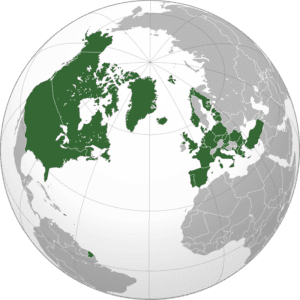
Member states shaded in dark green
As of 2022, NATO member states jointly contribute to roughly 55 per cent of global military expenditure, while its collective military personnel amount to approximately 3.5 million.
NATO’s expansion has occurred on multiple occasions, most recently with Finland’s accession in April 2023 and Sweden’s imminent membership. Ukraine, Georgia and Bosnia and Herzegovina are recognised as potential members of NATO. While several other nations either joined NATO’s Partnership for Peace programme or maintained structured dialogue initiatives with the organisation, the alliance’s expansion has led to tensions with non-member Russia.
Frequently Asked Questions
- What is NATO?
NATO stands for the North Atlantic Treaty Organization. It is an intergovernmental military alliance established in 1949, from North America and Europe.
- What is the primary purpose of NATO?
NATO's primary purpose is to ensure the freedom and security of its members through political and military means. It provides a framework for cooperation and collective defence, where an attack on one member is considered an attack on all, invoking Article 5 of the NATO treaty.
- How many countries are in NATO?
As of September 2023, NATO has 31 member countries - 29 European and two North American. The founding members (1949) include Belgium, Canada, Denmark, France, Iceland, Italy, Luxembourg, The Netherlands, Norway, Portugal, the UK, and the US. Other member countries include Greece, Turkey, Germany, Spain, Czechia, Hungary, Poland, Bulgaria, Estonia, Latvia, Lithuania, Romania, Slovakia, Slovenia, Albania, Croatia, Montenegro, North Macedonia, and Finland.

